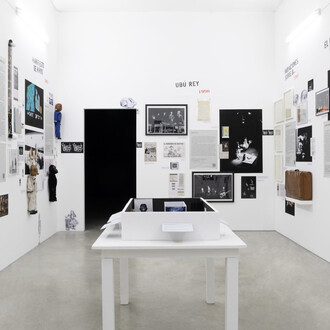I.
The great Gothic cathedrals were born as altars to sublime experiences; to heaven with its expressions in light, wind, and rain. They were not raised to shelter the faithful but, on the contrary, to expose them to the elements and awaken divine wonder. The artisans who intuitively acted as architects achieved moving effects: with flying buttresses, they liberated the walls; with stained-glass windows, they let in and filtered colored light; and with clusters of elongated columns, they suggested a surge upward. That spiritual exposure was meant to recall human smallness while summoning the sublime.
The Renaissance placed Man at the center and brought with it the illusion (and the need) for refuge in the mind and its ability to plan. Architecture became the most calculated clarity; transepts and naves, engineering challenges. The “outside” was domesticated, and control became a virtue, just as planning was a guarantee of comfort.
II.
Alejandra Barreda navigated this contrast in her own studio. Previously, her paintings were constructed as Renaissance works: long-planned compositions, calculated palettes, and gestures tamed by the project, the master plan. The safety of refuge contributed to the creation of an undoubtedly coherent body of work. However, for this exhibition, it seems Barreda took a Gothic turn: metaphorically opening her practice to a methodological openness. First with uncertain and slow steps, but then with rhythm and persistence, she crossed the door, traversed the hall, leaving the house behind to encounter what lurks when we are no longer in our comfort zone.
The works in Intemperie are the result of a process where there is no longer a projective script, but rather a new and established predisposition to listen to what emerges in the plot—the initial scribble, the residual gesture in the notebook before reaching the frame, the fleeting line, the playful palette. An active listening that inverts hierarchies and is more like a pas de deux than a fixed choreography. Because, as Rebeca Solnit points out in her guide, getting lost is another good way to find yourself. It’s deciphering the unexpected. Giving shape to what emerges in the environment.
III.
The new paintings breathe that attentive arrhythmia. In the absence of a project that dictates everything, the studio becomes a threshold: there is no refuge or script, only a few guidelines to follow.
The title Intemperie is not just a metaphor. It’s a methodology. A way of deliberately disorienting oneself, so that the painting breathes differently. Not from the house, but from the open sky. And although at first it provokes vertigo—losing the familiar roofs—the gaze soon sharpens. One learns to breathe risk. Then it happens: the night is beautiful. There is no refuge, but there is wonder. And a multitude of stars shine.
(Text by Mariana Rodríguez Iglesias. Buenos Aires, autumn of 2025)









![Various artists, Tramoya [Stagecraft], exhibition view. Courtesy of Museo de Arte Moderno de Buenos Aires](http://media.meer.com/attachments/7b634d843c1effc76d8d97ac251e63a3ca21b283/store/fill/330/330/4e1ca5a8881d5780a8ebcddde81382609430ae6a59e4505a831583cc0ea1/Various-artists-Tramoya-Stagecraft-exhibition-view-Courtesy-of-Museo-de-Arte-Moderno-de-Buenos.jpg)






